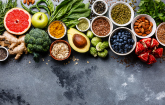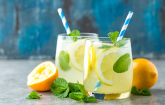
HYDERABAD, India, Nov. 4, 2025 /PRNewswire/ -- According to Mordor Intelligence, the organic baby food market is valued at USD 5.91 billion in 2025 and is expected to reach USD 10.59 billion by 2030, expanding at a CAGR of 12.37% during 2025-2030. The organic baby food market's rapid ascent is shaped by heightened awareness of ingredient safety, growing trust in certified organic products, and rising household incomes that enable premium spending on infant nutrition. Enhanced certification standards, transparent labeling, and robust e-commerce penetration are bridging the gap between urban and rural consumers, fostering a more inclusive and competitive global market.
Emerging Trends
Parents today are more informed than ever; scrutinizing ingredient lists and certifications before purchasing baby food. This awareness has catalyzed a shift toward products free from artificial additives, GMOs, and preservatives. As sustainability and safety emerge as dominant purchase drivers, brands are positioning organic baby food as a symbol of responsible parenting. Transparency around sourcing, farming methods, and manufacturing practices continues to define brand credibility, with certifications such as USDA Organic and EU Organic Standard serving as key trust indicators.
Beyond clean-label appeal, the market is witnessing rapid innovation in formulation science. Functional nutrition enriched with probiotics, omega-3 fatty acids, and essential vitamins is becoming the new benchmark in premium organic baby foods. Parents are also leaning toward allergen-free and hypoallergenic products to cater to growing concerns around infant sensitivities, giving rise to specialized product lines that blend nutrition with health assurance.
Growth Determinants and Competitive Shifts
The surge in working women worldwide has reshaped purchasing patterns, emphasizing convenience without compromising quality. This demographic transformation has increased demand for ready-to-feed organic meals, puree pouches, and formula powders that align with busy lifestyles. Direct-to-consumer (D2C) subscription models are booming, offering personalized meal plans, doorstep delivery, and product freshness assurance, an approach pioneered by brands like Little Spoon and Once Upon a Farm.
Meanwhile, rising birth rates in developing economies continue to expand the customer base for infant nutrition products. Emerging middle-class consumers in Asia-Pacific and Africa are demonstrating a growing preference for organic-certified offerings, associating them with safety, purity, and global quality standards. This behavioral shift is prompting both global giants and local startups to diversify portfolios with region-specific flavors and formulations that cater to diverse cultural preferences.
For a full breakdown of market size, segmentation data, and competitive intelligence, access the details of the Mordor Intelligence report: https://www.mordorintelligence.com/industry-reports/organic-baby-food-market?utm_source=prnewswire
Organic Baby Food Market Structure and Segment Outlook
By Product Type
- Milk Formula
- Infant Formula
- Follow-up Milk Formula
- Grow-up Milk Formula
- Specialty Formula
- Prepared Baby Food
- Dried Baby Food
By Age Group
- 0–6 Months
- 6–12 Months
- 12–24 Months
- More than 24 Months
By Packaging Type
- Pouches
- Jars/Bottles
- Tetra-Pak/Cartons
- Others (Snap-pots, Stick-packs)
By Distribution Channel
- Supermarkets/Hypermarkets
- Pharmacies and Drugstores
- Specialty Stores
- Online Retailers
- Other Distribution Channels
Regional Organic Baby Food Market Landscape
- Asia-Pacific stands as the most influential region, driven by rising disposable incomes, rapid urbanization, and strong e-commerce ecosystems in countries such as China and India. The region's growing population and increasing awareness of organic certification standards are accelerating adoption across both urban and semi-urban centers.
- North America and Europe organic baby food market continue to anchor global leadership through premium brand portfolios, advanced supply chains, and rigorous safety regulations. These mature markets emphasize transparency and scientific validation, with innovation driven by sustainability mandates and clean-label commitments.
Get more insights about the Europe organic baby food market - https://www.mordorintelligence.com/industry-reports/europe-organic-baby-food-market?utm_source=prnewswire
Market Share Analysis and Competitive Insights
The market exhibits moderate consolidation, featuring established organic baby food companies such as Nestlé S.A., Danone S.A., The Hain Celestial Group Inc., Hero Group, and HiPP GmbH & Co. KG alongside agile startups that specialize in premium organic offerings. Industry pioneers are investing heavily in R&D and acquisitions to maintain relevance amid evolving consumer expectations.
Recent strategic moves such as Danone's acquisition of Kate Farms to expand its plant-based portfolio and Babylife Organic's launch of Regenerative Organic Certified lines at Whole Foods underscore the market's shift toward sustainability and innovation.
As the industry moves forward, companies that combine sustainability, innovation, and digital engagement are likely to shape the next chapter of the global organic baby food market.
Check out related reports published by Mordor Intelligence:
Baby Food Packaging Market - The baby food packaging market is valued at USD 8.26 billion in 2025 and is projected to reach USD 11.76 billion by 2030, growing at A CAGR of 7.32%. The report segments the market by material (plastic, paperboard, metal, glass, bioplastics), package type (bottles, cartons, jars, pouches, bag-in-box), product (liquid milk formula, dried baby food, powder milk formula, prepared baby food, baby snacks), and geography.
Infant Nutrition Market - The infant nutrition market is valued at USD 101.70 billion in 2025 and is projected to reach USD 144.71 billion by 2030, growing at a CAGR of 7.31%. The market is segmented by product (infant formula and baby food), form (powder, liquid concentrate, and more), ingredient (cow-milk based, goat-milk based, and more), distribution channel (hypermarkets & supermarkets, pharmacy & drug stores, e-commerce, and more), and geography.
Infant Formula Ingredients Market - The infant formula ingredients market is estimated at USD 25.48 billion in 2025 and is projected to reach USD 34.17 billion by 2030, expanding at a CAGR of 6.81% during the forecast period. The market is segmented by ingredient (carbohydrates, fats and oils, proteins, and more), source (cow milk, goat milk, and more), form (powder, liquid and semi-liquid), certification/nature (conventional and organic), application (standard infant formula (stage 1), and more), and geography (North America, Europe, and more).
About Mordor Intelligence:
Mordor Intelligence is a trusted partner for businesses seeking comprehensive and actionable market intelligence. Our global reach, expert team, and tailored solutions empower organizations and individuals to make informed decisions, navigate complex markets, and achieve their strategic goals.
With a team of over 550 domain experts and on-ground specialists spanning 150+ countries, Mordor Intelligence possesses a unique understanding of the global business landscape. This expertise translates into comprehensive syndicated and custom research reports covering a wide spectrum of industries, including aerospace & defense, agriculture, animal nutrition and wellness, automation, automotive, chemicals & materials, consumer goods & services, electronics, energy & power, financial services, food & beverages, healthcare, hospitality & tourism, information & communications technology, investment opportunities, and logistics.
For any inquiries, please contact:
[email protected]
https://www.mordorintelligence.com/contact-us
Logo: https://mma.prnewswire.com/media/2746908/Mordor_Intelligence_Logo.jpg
SOURCE Mordor Intelligence Private Limited






Share this article